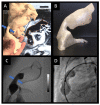The Role of 3D Printing in Planning Complex Medical Procedures and Training of Medical Professionals-Cross-Sectional Multispecialty Review
- PMID: 35329016
- PMCID: PMC8953417
- DOI: 10.3390/ijerph19063331
The Role of 3D Printing in Planning Complex Medical Procedures and Training of Medical Professionals-Cross-Sectional Multispecialty Review
Abstract
Medicine is a rapidly-evolving discipline, with progress picking up pace with each passing decade. This constant evolution results in the introduction of new tools and methods, which in turn occasionally leads to paradigm shifts across the affected medical fields. The following review attempts to showcase how 3D printing has begun to reshape and improve processes across various medical specialties and where it has the potential to make a significant impact. The current state-of-the-art, as well as real-life clinical applications of 3D printing, are reflected in the perspectives of specialists practicing in the selected disciplines, with a focus on pre-procedural planning, simulation (rehearsal) of non-routine procedures, and on medical education and training. A review of the latest multidisciplinary literature on the subject offers a general summary of the advances enabled by 3D printing. Numerous advantages and applications were found, such as gaining better insight into patient-specific anatomy, better pre-operative planning, mock simulated surgeries, simulation-based training and education, development of surgical guides and other tools, patient-specific implants, bioprinted organs or structures, and counseling of patients. It was evident that pre-procedural planning and rehearsing of unusual or difficult procedures and training of medical professionals in these procedures are extremely useful and transformative.
Keywords: 3D printing; additive manufacturing; cardiac surgery; cardiology; gynecology; head and neck surgery; mandible reconstruction; obstetrics; oncology; orthopedics; otolaryngology; outcomes; radiotherapy; simulation; surgery; three-dimensional printing; training; trauma; urology.
Conflict of interest statement
The authors declare no conflict of interest.
Figures











References
-
- Antreas K., Piromalis D. Employing a Low-Cost Desktop 3D Printer: Challenges, and How to Overcome Them by Tuning Key Process Parameters. Int. J. Mech. Appl. 2021;10:11–19. doi: 10.5923/j.mechanics.20211001.02. - DOI
-
- Scanlan A.B., Nguyen A.V., Ilina A., Lasso A., Cripe L., Jegatheeswaran A., Silvestro E., McGowan F.X., Mascio C.E., Fuller S., et al. Comparison of 3D Echocardiogram-Derived 3D Printed Valve Models to Molded Models for Simulated Repair of Pediatric Atrioventricular Valves. Pediatr. Cardiol. 2018;39:538–547. doi: 10.1007/s00246-017-1785-4. - DOI - PMC - PubMed
Publication types
MeSH terms
LinkOut - more resources
Full Text Sources

